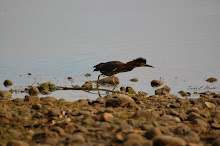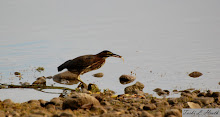
Song Lake and Cyanobacterial Blooms
These blooms have been visually identified by experts as blue-green algae in bloom. This picture was taken Sept. 6th 2009 on the north end of the lake.
Last year, cyanobacteria ('bluegreen algae') were identified in our lake. This year, they bloomed. When the algae bloom they release a neurotoxin that has the potential to be very harmful
(even fatal) to humans and pets. They upset the food chain in the lake, killing desirable fish. These toxic algae will significantly degrade the quality of life on the lake, and diminish property values.
What this means for Song Lake is not clear, but given the higher phosphorus concentrations which are increasing all algae, their presence is cause for serious concern. When these blooms are seen, it is recommended that humans and pets stay out of the water.
See the CDC site for more information at http://www.cdc.gov/hab/
Why is This Happening?
For the past two years, Song Lake has participated in the New York State Citizen’s Statewide Lake Assessment Program (CSLAP). The report for 2008 indicated that the water quality in our lake has declined since 1988. The main indicators of concern are reduced water clarity (mainly due to increases in algae) and higher phosphorus levels in the lake. The report states: “it is likely
that lake management activities directed toward increasing water clarity and reducing algal blooms in the lake should target nutrient loading to the lake. Indications are that the primary lake nutrients come from the watershed.” The report continues: “Given the moderately high lake productivity, management of water quality conditions in Song Lake should focus on reducing
nutrient loading to the lake, through maintaining septic systems, shoreline buffer zones, limited use of lawn fertilizers, minimizing land disturbances in the near-lake watershed, and localized stormwater management. The lake association is also advised to minimize introductions of exotic plants and animals from public and private launching areas into the lake, particularly
given their abundance in many nearby lakes.” The full content of the report is available in pdf form by contacting any of the Song Lake Watershed Planning Committee.
What Can We Do?
Understanding the impact we all have on our small watershed is the key to keeping our properties valuable, and our lake swimmable, fishable and enjoyed by all.
The Song Lake Watershed Committee is committed to working hand in hand with all those who have a stake in conserving our lake: property owners, renters, fisher folk, boaters, swimmers, birders and anyone who enjoys this unique lake.
This year’s cyanobacterial blooms make it clear that we have a problem.
The Waterhsed committee is working with NYSFOLA and they are working with the State Department of Health on our behalf. We are also working with scientists at ESF and continue to work with CCS&W. This is an extremely serious threat to our lake, our health, our pets’s health;
our fish population and our property values.
There are no magic bullets, but here are some things we can do.
Household Activities:
Clean and maintain your septic system.
Get it Pumped! Have your septic pumped regularly. Leaking septic systems can contribute to nutrients and bacteria getting into the lake. This can prevent the lake's use for recreational
activities. It can also cause over enrichment and algae blooms.
Use phosphate free cleaning agents.
activities. It can also cause over enrichment and algae blooms.
Use phosphate free cleaning agents.
Using detergents containing phosphorous to wash boats, cars, and pets in locations where the waste water can run off into the lake adds unneeded nutrients.
Never use phosphorus on your lawn and reduce or eliminate fertilizing.
Fertilizing at the lakeshore can also contribute excess nutrients to the lake. This can greatly affect water ecology and recreational activities. (Remember a green lawn creates a green lake.)
Keep a buffer.
Never use phosphorus on your lawn and reduce or eliminate fertilizing.
Fertilizing at the lakeshore can also contribute excess nutrients to the lake. This can greatly affect water ecology and recreational activities. (Remember a green lawn creates a green lake.)
Keep a buffer.
The area between your house and the lake should be an area of beauty and stability. Healthy, native plants along the shoreline increase natural filtration and prevent erosion. By clearing vegetation near and on the lake shore you are actually removing the natural buffering system that helps absorb nutrients and sediment runoff.
Boating Activities:
Don’t churn the sediments. When the phosphorus is trapped in the sediments, it is not available for use. Unfortunately, when powerful outboard motors and jet skis are used in shallow areas, or at high speeds, they churn up nutrient laden sediments (phosphorus) that support algae growth and destroy aquatic life.
Share Your Observations:
Please call one of the watershed members below if you see something that is unusual in the water or around the watershed area.
For more information, please contact The Song Lake watershed committee at SongLakeIssues@aol.com.
Or call: Tony George -696-8045, Marjie Grillo -696-5963, Tarki Heath -696-5262, or
Or call: Tony George -696-8045, Marjie Grillo -696-5963, Tarki Heath -696-5262, or
Gloria Wright -696-5524.



